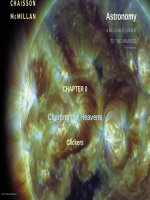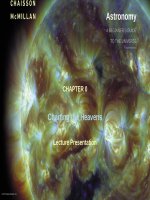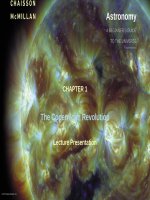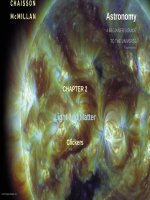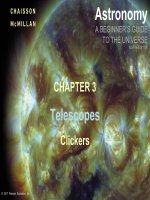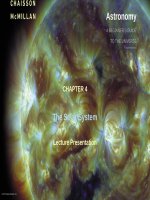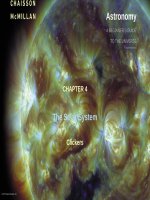Astronomy a beginners guide to the universe 8th CHaisson mcmillan chapter 05 clicker questions
Bạn đang xem bản rút gọn của tài liệu. Xem và tải ngay bản đầy đủ của tài liệu tại đây (1.48 MB, 21 trang )
Astronomy
A BEGINNER’S GUIDE
TO THE UNIVERSE
EIGHTH EDITION
CHAPTER 5
Earth and Its Moon
Clickers
© 2017 Pearson Education, Inc.
Question 1
The Moon’s internal structure is similar to Earth’s, but the Moon lacks
a)
b)
c)
d)
© 2017 Pearson Education, Inc.
an atmosphere.
a hydrosphere.
a magnetosphere.
all of the above.
Question 1
The Moon’s internal structure is similar to Earth’s, but the Moon lacks
a)
b)
c)
d)
an atmosphere.
a hydrosphere.
a magnetosphere.
all of the above.
Explanation: Both Earth and the Moon
have a core, mantle, and crust, but
Earth has a liquid water-rich layer, air,
and a magnetic field.
© 2017 Pearson Education, Inc.
Question 2
The principal greenhouse gases in our present atmosphere are
a)
b)
c)
d)
e)
© 2017 Pearson Education, Inc.
hydrogen and helium.
oxygen and nitrogen.
water vapor and carbon dioxide.
methane and ammonia.
sulfuric acid vapor and CO2.
Question 2
The principal greenhouse gases in our present atmosphere are
a)
b)
c)
d)
e)
hydrogen and helium.
oxygen and nitrogen.
water vapor and carbon dioxide.
methane and ammonia.
sulfuric acid vapor and CO2.
Explanation: A greenhouse gas lets
shorter-wavelength light pass through,
but absorbs longer-wavelength light.
© 2017 Pearson Education, Inc.
Question 3
Without the greenhouse effect in our atmosphere
a)
b)
c)
d)
e)
© 2017 Pearson Education, Inc.
we would not have to worry about ecological problems.
the Earth’s oceans would be frozen.
the amount of nitrogen and oxygen would be much less.
the icecaps would have melted.
global warming would still occur.
Question 3
Without the greenhouse effect in our atmosphere
a)
b)
c)
d)
e)
we would not have to worry about ecological problems.
the Earth’s oceans would be frozen.
the amount of nitrogen and oxygen would be much less.
the icecaps would have melted.
global warming would still occur.
Explanation: Earth’s greenhouse effect
makes the planet about 40ºC hotter
than it would otherwise be. This raises
the average surface temperature
above the freezing point of water.
© 2017 Pearson Education, Inc.
Question 4
The region around Earth where the magnetic field traps charged particles is the
a)
b)
c)
d)
e)
© 2017 Pearson Education, Inc.
ozone layer.
exosphere.
Van Allen radiation belts.
corona.
aurora borealis and australis.
Question 4
The region around Earth where the magnetic field traps charged particles is the
a)
b)
c)
d)
e)
ozone layer.
exosphere.
Van Allen radiation belts.
corona.
aurora borealis and australis.
Explanation: The Earth’s
magnetosphere influences the charged
particles of the solar wind. Some particles are channeled toward the poles, creating the aurora.
© 2017 Pearson Education, Inc.
Question 5
At what lunar phase would the variation between high and low tides be greatest?
a)
b)
c)
d)
e)
© 2017 Pearson Education, Inc.
New Moon
Waxing crescent Moon
Full Moon
Third-quarter Moon
Both new and full Moon
Question 5
At what lunar phase would the variation between high and low tides be greatest?
a)
b)
c)
d)
e)
New Moon
Waxing crescent Moon
Full Moon
Third-quarter Moon
Both new and full Moon
Explanation: At new and full
Moon phases, the Sun and Moon
combine to stretch the Earth and its oceans even more.
We see higher high tides and lower low tides.
© 2017 Pearson Education, Inc.
Question 6
What force aligned the Moon’s near side to constantly face Earth?
a)
b)
c)
d)
e)
© 2017 Pearson Education, Inc.
The Sun’s gravity
Earth’s magnetic field
Earth’s tidal force
The solar wind
The Moon’s magnetic field
Question 6
What force aligned the Moon’s near side to constantly face Earth?
a)
b)
c)
d)
e)
The Sun’s gravity
Earth’s magnetic field
Earth’s tidal force
The solar wind
The Moon’s magnetic field
Explanation: Just as the Moon
creates tides on Earth with its gravitational force, the Earth affects the Moon, too. Because of Earth’s tidal force,
the Moon spins once a month.
© 2017 Pearson Education, Inc.
Question 7
Lunar maria are found
a)
b)
c)
d)
e)
© 2017 Pearson Education, Inc.
uniformly all over the Moon.
mostly on the side facing Earth.
mostly on the far side of the Moon.
only in the dark areas, out of sunlight.
in the highlands, among mountains.
Question 7
Lunar maria are found
a)
b)
c)
d)
e)
uniformly all over the Moon.
mostly on the side facing Earth.
mostly on the far side of the Moon.
only in the dark areas, out of sunlight.
in the highlands, among mountains.
Explanation: Because the Moon keeps its
near side always facing Earth, that side has
a thinner crust and is also less cratered.
© 2017 Pearson Education, Inc.
Question 8
A planetary atmosphere with ozone could protect surface dwellers from
a)
b)
c)
d)
e)
© 2017 Pearson Education, Inc.
ultraviolet radiation.
charged particles in the solar wind.
meteor impacts.
optical radiation.
radar waves.
Question 8
A planetary atmosphere with ozone could protect surface dwellers from
a)
b)
c)
d)
e)
ultraviolet radiation.
charged particles in the solar wind.
meteor impacts.
optical radiation.
radar waves.
Ozone in the stratosphere (about 30−50 km high)
absorbs UV light, and heats the upper
atmosphere.
© 2017 Pearson Education, Inc.
Question 9
Which of these is NOT a result of the Earth’s magnetic field?
a)
b)
c)
d)
e)
© 2017 Pearson Education, Inc.
A compass pointing north
Aurorae
The Van Allen radiation belts
Volcanic eruptions
The comet-like tail of charged particles that extends past our Moon
Question 9
Which of these is NOT a result of the Earth’s magnetic field?
a)
b)
c)
d)
e)
A compass pointing north
Aurorae
The Van Allen radiation belts
Volcanic eruptions
The comet-like tail of charged particles that extends past our Moon
Explanation: Our planet’s magnetosphere is generated by Earth’s rotation and its liquid metal core. In contrast, the
Moon doesn’t have a magnetic field.
© 2017 Pearson Education, Inc.
Question 10
Today, which of these theories best explains the Moon’s origin?
a)
b)
c)
d)
e)
© 2017 Pearson Education, Inc.
The fission theory
The giant impact theory
The capture theory
The coformation theory
The fusion theory
Question 10
Today, which of these theories best explains the Moon’s origin?
a)
b)
c)
d)
e)
The fission theory
The giant impact theory
The capture theory
The coformation theory
The fusion theory
Explanation: The giant impact theory seems
to explain why the Moon is similar to Earth’s
mantle and why it doesn’t have a dense core.
© 2017 Pearson Education, Inc.
